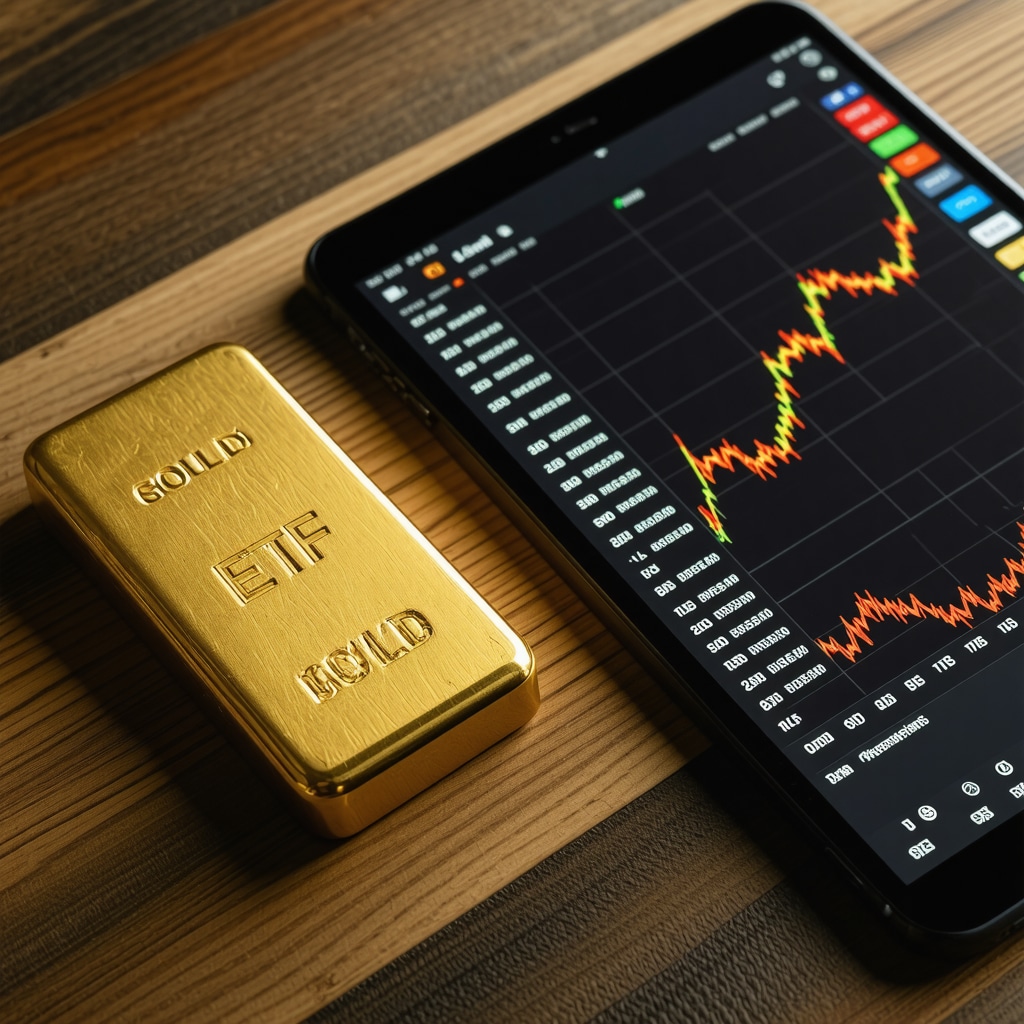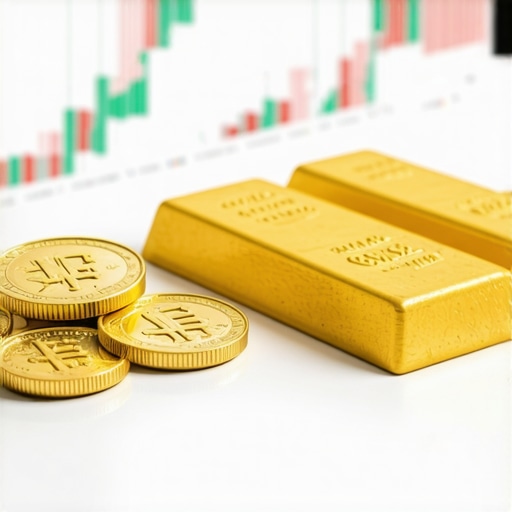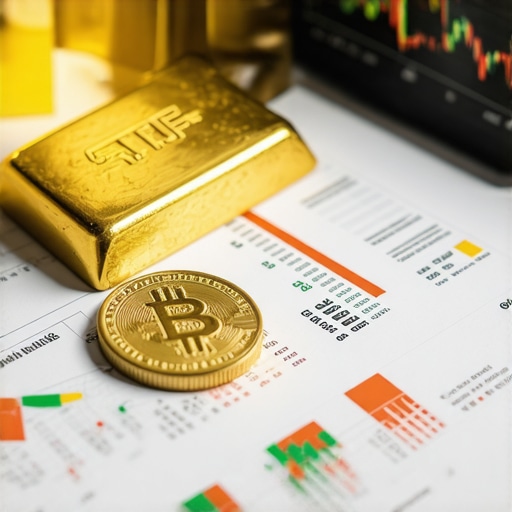Unveiling the Golden Dilemma: Physical Gold or Gold ETFs?
In the evolving landscape of 2027, investors face a captivating crossroads when it comes to gold investment. With inflationary pressures, geopolitical uncertainties, and volatile markets dominating headlines, the age-old question resurfaces: should one choose physical gold or gold ETFs as the premier investment vehicle? Both options offer compelling advantages, yet they cater to distinct investor profiles and strategic goals. This expert guide dives deeply into these nuances, illuminating pathways for prudent wealth preservation and growth.
Holding Tangibility: The Enduring Allure of Physical Gold
Physical gold, encompassing bullion bars and coins, represents a tangible asset that has withstood millennia as a store of value. Its intrinsic appeal lies in direct ownership, immune to counterparty risks inherent in financial instruments. Investors often favor physical gold for its privacy, sovereignty, and ability to hedge against systemic financial risks. For example, during the 2008 financial crisis, physical gold retained intrinsic value even when markets plunged, underscoring its role as a safe haven.
However, owning physical gold demands considerations of secure storage, insurance, and liquidity. Costs related to vaulting and the potential premium over spot prices can impact net returns. Therefore, investors must assess their comfort with logistics and the intent behind holding gold — whether for immediate liquidity or long-term security.
Digital Gold: Navigating the Advantages of Gold ETFs in 2027
Gold Exchange-Traded Funds (ETFs) provide an innovative, accessible avenue for gold investment without the encumbrance of physical storage. These funds track gold prices closely and offer ease of trading akin to stocks, providing liquidity and diversification benefits. For instance, the SPDR Gold Shares ETF (GLD) remains one of the most liquid and widely tracked gold ETFs globally.
Gold ETFs also enable fractional ownership, lower transaction costs, and integration within broader portfolio strategies, facilitating dynamic asset allocation. Nonetheless, they carry counterparty risk, management fees, and may be subject to regulatory changes affecting their operation. Investors must weigh these factors against the convenience and cost efficiency gold ETFs present.
How Should an Investor Decide Between Physical Gold and Gold ETFs in 2027?
The choice hinges on individual investment objectives, risk tolerance, and time horizon. Physical gold suits those prioritizing direct asset control, tangible security, and long-term preservation against systemic shocks. Conversely, gold ETFs appeal to investors seeking liquidity, portfolio flexibility, and cost-effective exposure to gold price movements.
Contextual factors such as geopolitical risks, monetary policy trends, and market volatility also influence this decision. For example, in a high inflation environment, physical gold might offer superior psychological comfort, while ETFs enable quick tactical adjustments. An informed investor might even consider a hybrid approach, balancing physical holdings with ETF positions to optimize risk and return profiles.
For a comprehensive understanding of gold investment options and strategies, explore our detailed analysis of bullion versus ETFs, which delves deeper into comparative advantages and practical guidance.
Expert Insight: Real-World Impacts of Central Bank Gold Purchases
One often overlooked factor shaping gold investments is the role of central bank gold acquisitions. Their strategic purchases can tighten supply and influence global prices significantly. Understanding this dynamic is vital for investors weighing physical gold’s premium costs against ETF exposure to market-driven prices. For a detailed exploration, see how central bank gold purchases impact market dynamics.
Investors armed with this knowledge can better anticipate price trends and make choices aligned with macroeconomic shifts.
Engage with the Gold Investment Community
Have you experimented with both physical gold and gold ETFs in your portfolio? Share your experiences or questions in the comments below to enrich the collective understanding of gold investment strategies in 2027. For ongoing expert insights and market updates, consider sharing this article with fellow investors.
Source: World Gold Council, “Gold as a Strategic Asset in Portfolio Management,” https://www.gold.org/goldhub/research/gold-as-a-strategic-asset
Blending Strategies: A Personal Take on Diversifying Gold Investments
Reflecting on my own journey with gold investment, I’ve found that neither physical gold nor gold ETFs alone provide the full security and flexibility I seek. Instead, a thoughtful blend tailored to my goals has worked best. For instance, physical gold offers a comforting sense of ownership during turbulent times, while ETFs provide agility to respond to market shifts swiftly.
One memorable experience was during a period of unexpected geopolitical tension last year. Holding physical gold gave me peace of mind as markets reacted unpredictably, but my gold ETF positions also allowed me to capitalize on short-term price movements without the hassle of selling physical assets.
Unpacking the Influence of Central Banks on Gold Markets
Another dimension worth considering is how central banks’ gold activities shape market dynamics. Central banks often buy gold to diversify reserves and signal economic confidence, which tightens supply and can drive prices upward. According to the World Gold Council, these purchases have a pronounced effect on long-term price trends and investor sentiment (Gold as a Strategic Asset in Portfolio Management).
Understanding this helped me better time my investments, aligning physical gold acquisitions with periods of increased central bank buying while leveraging ETFs for more nimble exposure during quieter phases. For those interested in a deeper dive, exploring how central bank gold purchases influence global prices offers valuable insights.
What’s Your Ideal Gold Investment Mix in Today’s Market?
Given the nuanced pros and cons, I’m curious: how do you balance physical gold and ETFs in your portfolio? Do you lean towards the tangible security of bullion, or prefer the liquidity and convenience of ETFs? Your experiences can shed light on strategies that work in diverse economic climates.
Feel free to join the conversation by sharing your thoughts or questions below. If you found this perspective helpful, consider sharing it with others navigating the golden crossroads. For more detailed strategies, check out our guides on gold IRA investment strategies and advanced gold trading techniques.
Decoding Central Bank Gold Reserves: Strategic Signals for Sophisticated Investors
Central banks play a pivotal role not only as custodians of national wealth but also as influential market participants whose gold reserve policies ripple through global markets. Their accumulation or liquidation of gold reserves often serves as an economic barometer, reflecting shifts in monetary policy, geopolitical risk tolerance, and currency diversification strategies. For investors aiming to anticipate gold price trajectories, a nuanced understanding of central bank activities is indispensable.
In recent years, central banks from emerging economies have emerged as aggressive buyers, seeking to diversify away from US dollar reserves amid evolving global power dynamics. This shift elevates gold’s strategic importance beyond mere asset class allocation, positioning it as a geopolitical hedge. Consequently, periods marked by heightened central bank purchases correlate with constrained physical gold availability and upward price pressure, phenomena that sophisticated investors can capitalize on by adjusting the balance of physical holdings and ETF exposure.
How Can Investors Leverage Central Bank Gold Purchase Patterns to Optimize Portfolio Timing?
Investors seeking to incorporate central bank trends into timing strategies should monitor official disclosures from entities like the International Monetary Fund and the World Gold Council, which publish detailed reports on reserve changes. Advanced market analytics tools can also track derivatives markets and futures positioning to infer central bank activity indirectly. By aligning physical gold acquisitions during phases of robust central bank buying, investors can potentially acquire assets at a premium that may appreciate further as supply tightens. Conversely, ETFs offer nimbleness to reduce exposure if signals suggest a lull or liquidation phase.
Such a dual-pronged strategy requires vigilance and access to high-quality data, emphasizing the importance of continuous market education and expert consultation. As noted by the World Gold Council in their comprehensive analysis Gold as a Strategic Asset in Portfolio Management, understanding these macro forces can materially enhance portfolio resilience and returns.
Hybrid Gold Portfolio Architectures: Engineering the Optimal Blend for 2027
Moving beyond binary choices, the future-forward investor often embraces hybrid portfolio structures that synergize the strengths of physical gold and ETFs. This approach blends the tangible security and psychological comfort of bullion with the liquidity, flexibility, and cost efficiency of ETFs. The key lies in tailoring the ratio and timing to individual risk profiles, market outlooks, and investment horizons.
For example, an allocation model might allocate 40–60% to physical gold, stored securely and insured, to serve as a long-term inflation hedge and crisis buffer. The remaining 40–60% could be allocated to gold ETFs, allowing for responsive rebalancing and tactical exposure to price volatility. This diversified stance helps mitigate risks associated with storage costs, counterparty exposure, and regulatory shifts while optimizing market participation.
Furthermore, integrating gold-themed derivatives and options can amplify strategic flexibility, enabling investors to hedge or speculate within defined risk parameters. However, such advanced techniques necessitate expertise and vigilant risk management.
What Are the Risks and Rewards of Incorporating Gold Derivatives Within a Hybrid Investment Strategy?
While derivatives like gold futures and options offer leverage and hedging potential, they also introduce complexity and heightened risk. Misjudgment in timing or volatility can exacerbate losses. Thus, these instruments are best reserved for seasoned investors or those working closely with professional advisors. When deployed judiciously, derivatives can enhance portfolio returns and provide insurance against adverse market moves, complementing the stability of physical and ETF holdings.
Given the intricacy of these strategies, continuous education and engagement with authoritative resources, such as the Investopedia guide on gold futures, are essential to mastering their use.
Embracing Dynamic Gold Allocation: The Pathway to Sophisticated Wealth Preservation
In the complex, interconnected financial environment of 2027, static gold investment strategies fall short of maximizing potential. A dynamic approach — adjusting allocations in response to evolving macroeconomic indicators, central bank moves, and market sentiment — offers a sophisticated pathway to wealth preservation and growth.
Investors are encouraged to maintain an active dialogue with market experts, utilize advanced analytical tools, and remain vigilant to global developments influencing gold’s role within diversified portfolios. Experimenting with hybrid models and derivative overlays, underpinned by rigorous risk assessment, can unlock nuanced opportunities beyond traditional investment paradigms.
If you are eager to deepen your mastery of gold investment strategies and explore bespoke portfolio construction, dive into our advanced resources and expert analyses. Your journey towards optimized gold allocation starts with informed decisions and strategic adaptability.
Strategic Timing: Harnessing Macroeconomic Indicators for Gold Allocation
In the intricate arena of gold investment, timing transcends mere market entry and exit points — it demands a sophisticated reading of macroeconomic indicators such as inflation expectations, currency fluctuations, and geopolitical tensions. Expert investors capitalize on signals from global financial institutions and central banks to anticipate shifts in gold demand and price trajectories. For example, tightening monetary policies often precipitate short-term gold price corrections, whereas rising geopolitical instability can herald bullish trends.
Integrating real-time economic data analytics and sentiment indices enables investors to calibrate their physical and ETF holdings dynamically, optimizing performance while mitigating risks associated with abrupt market swings. This proactive posture distinguishes advanced portfolios from static allocations, fostering resilience amid volatility.
Innovative Custodial Solutions: The Evolution of Secure Physical Gold Ownership
Recent advancements in custodial technologies have revolutionized the management of physical gold assets. High-security vaulting infrastructures now incorporate biometric access controls, blockchain-enabled provenance tracking, and insured storage offerings tailored for high-net-worth individuals. These innovations diminish traditional drawbacks of physical gold ownership, such as security concerns and liquidity constraints, by facilitating seamless transfer and verification processes.
Moreover, digital platforms integrating physical gold custody with ETF liquidity allow investors to fluidly transition between tangible and paper assets, marrying security with flexibility. The confluence of technology and gold investment thus unlocks new paradigms for portfolio architects seeking to harmonize asset integrity with operational efficiency.
How Do Blockchain-Enabled Custodial Services Impact the Transparency and Liquidity of Physical Gold Investments?
Blockchain technology is increasingly leveraged to enhance transparency, authenticity verification, and liquidity in physical gold markets. By recording provenance and ownership transfers on immutable ledgers, investors gain confidence in asset legitimacy and can facilitate peer-to-peer transactions without intermediaries. This innovation reduces counterparty risk and expedites settlement processes, effectively bridging the liquidity gap traditionally associated with physical gold.
Leading firms pioneering blockchain-enabled custody, such as Paxos and Perth Mint, demonstrate the scalability and security of these solutions. According to the World Gold Council’s analysis, such technologies are poised to reshape gold ownership paradigms, empowering investors with unprecedented control and market responsiveness.
Sophisticated Risk Management: Incorporating Gold Derivatives and Hedging Techniques
Beyond traditional allocation, advanced investors exploit gold derivatives—including futures, options, and swaps—to fine-tune exposure and hedge against adverse price movements. These instruments enable strategic positioning to capitalize on market volatility or protect underlying holdings from unfavorable scenarios.
However, derivative utilization demands rigorous risk assessment frameworks. Ill-timed leverage can amplify losses, while mispriced options may erode returns. Hence, coupling derivatives with robust analytics, scenario modeling, and professional advisory is paramount to harnessing their benefits effectively.
Engage with Cutting-Edge Gold Investment Insights
Embracing these advanced strategies requires continuous learning and adaptive execution. To deepen your expertise and craft a gold portfolio that responds agilely to evolving global dynamics, we invite you to explore our specialized resources and join discussions with fellow sophisticated investors.
Share your thoughts or questions about integrating blockchain custody or derivatives into your gold strategy in the comments below. Elevate your investment approach by subscribing for regular expert analyses and market intelligence tailored to the discerning gold investor.
Frequently Asked Questions (FAQ)
What are the primary differences between physical gold and gold ETFs?
Physical gold involves direct ownership of tangible assets like bullion bars or coins, offering sovereignty and immunity from counterparty risk but requiring secure storage and insurance. Gold ETFs represent ownership of shares tied to gold prices, providing liquidity, ease of trading, and fractional ownership but carrying management fees and counterparty risk.
How does central bank gold purchasing influence gold prices and investment strategies?
Central banks’ gold acquisitions tighten physical gold supply and signal shifts in economic confidence, often driving prices upward. Investors can time physical gold purchases during heightened central bank buying phases to capitalize on supply constraints, while using ETFs to remain flexible during quieter periods.
Is it advisable to hold both physical gold and gold ETFs in a portfolio?
Yes, a hybrid strategy blends the tangible security of physical gold with the liquidity and flexibility of ETFs, optimizing risk management and responsiveness to market movements. Allocation ratios depend on individual goals, risk tolerance, and market outlooks.
What role do gold derivatives play in sophisticated gold investment strategies?
Gold derivatives like futures and options enable hedging, leverage, and tactical positioning to exploit market volatility. However, they introduce complexity and risk, necessitating expertise and stringent risk management to avoid amplified losses.
How can blockchain technology improve physical gold ownership?
Blockchain enhances transparency and provenance verification for physical gold, reducing counterparty risk and facilitating peer-to-peer transfers. This technology increases liquidity and trust while enabling seamless integration with digital gold platforms.
What macroeconomic indicators should investors monitor for gold allocation timing?
Investors should track inflation trends, central bank policies, currency fluctuations, and geopolitical tensions. These factors influence gold demand and price dynamics, guiding allocation adjustments between physical gold and ETFs.
Are there risks associated with holding physical gold during geopolitical crises?
Physical gold provides a safe haven during crises due to its tangibility and privacy. However, risks include storage security, potential confiscation in extreme cases, and liquidity challenges if rapid selling is required.
How do storage and insurance costs affect the returns on physical gold?
Secure storage and insurance incur ongoing expenses that can reduce net returns, especially for smaller holdings. Investors must factor these costs into their long-term investment calculations.
Can gold ETFs be considered a safe hedge against inflation?
Gold ETFs track gold prices closely and can serve as effective inflation hedges, offering convenient exposure without storage concerns. However, they carry management fees and counterparty risks absent in physical gold.
What resources can investors use to stay informed about gold market trends?
Authoritative reports from the World Gold Council, International Monetary Fund data, and specialized market analytics platforms provide essential insights for timely and informed gold investment decisions.
Trusted External Sources
- World Gold Council (WGC): As the leading authority on gold market research, WGC offers comprehensive data on gold demand, central bank activities, and strategic asset roles, underpinning informed investment decisions.
- International Monetary Fund (IMF): Provides detailed statistics on national reserve compositions and official gold holdings, enabling investors to track central bank gold purchase trends.
- Investopedia – Gold Futures and Derivatives Guides: Offers in-depth educational resources on gold derivatives, essential for understanding complex hedging and trading strategies.
- Perth Mint and Paxos Blockchain Custody Platforms: Pioneers in blockchain-enabled gold custody, demonstrating technological advancements enhancing transparency and liquidity in physical gold investments.
- Financial Times and Bloomberg Markets: Renowned financial news outlets delivering up-to-date macroeconomic analysis and geopolitical coverage impacting gold markets globally.
Conclusion
In the multifaceted gold investment landscape of 2027, discerning investors must navigate between the enduring tangibility of physical gold and the dynamic convenience of gold ETFs. Each avenue offers distinct advantages tailored to different risk appetites, liquidity needs, and strategic objectives. Central bank purchasing trends and macroeconomic indicators further add complexity but also opportunity, enabling sophisticated timing and allocation tactics.
Embracing hybrid portfolio architectures that blend physical holdings, ETFs, and selective derivatives can unlock superior resilience and growth potential. Moreover, technological innovations like blockchain custody solutions promise to transform ownership transparency and liquidity, propelling gold investment into a new era.
To harness these insights effectively, investors should commit to continuous education, leverage trusted research sources, and engage with expert communities. Share your experiences or questions below, and explore our expert resources to refine your gold investment approach for enduring success.










